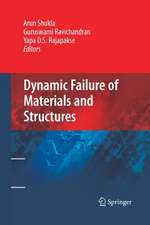Predictive Modeling of Dynamic Processes: A Tribute to Professor Klaus Thoma
Editat de Stefan Hiermaieren Limba Engleză Hardback – 10 sep 2009
Successfully blending crash simulation, hydrocode technology and impact engineering, this volume fills a gap in the current competing literature available.
| Toate formatele și edițiile | Preț | Express |
|---|---|---|
| Paperback (1) | 705.83 lei 43-57 zile | |
| Springer Us – 23 aug 2016 | 705.83 lei 43-57 zile | |
| Hardback (1) | 962.35 lei 22-36 zile | |
| Springer Us – 10 sep 2009 | 962.35 lei 22-36 zile |
Preț: 962.35 lei
Preț vechi: 1173.60 lei
-18% Nou
Puncte Express: 1444
Preț estimativ în valută:
184.20€ • 200.15$ • 154.83£
184.20€ • 200.15$ • 154.83£
Carte disponibilă
Livrare economică 31 martie-14 aprilie
Preluare comenzi: 021 569.72.76
Specificații
ISBN-13: 9781441907264
ISBN-10: 1441907262
Pagini: 460
Ilustrații: XX, 460 p.
Dimensiuni: 155 x 235 x 25 mm
Greutate: 0.93 kg
Ediția:2009
Editura: Springer Us
Colecția Springer
Locul publicării:New York, NY, United States
ISBN-10: 1441907262
Pagini: 460
Ilustrații: XX, 460 p.
Dimensiuni: 155 x 235 x 25 mm
Greutate: 0.93 kg
Ediția:2009
Editura: Springer Us
Colecția Springer
Locul publicării:New York, NY, United States
Public țintă
Professional/practitionerCuprins
I Simulation of Automotive Crash Processes.- Simulation of Recoverable Foams under Impact Loading.- The Numerical Simulation of Foam #x2013; An Example of Inter-Industrial Synergy.- Influence of Hardening Relations on Forming Limit Curves Predicted by the Theory of Marciniak, Kuczy#x0144;ski, and Pokora.- The Challenge to Predict Material Failure in Crashworthiness Applications: Simulation of Producibility to Serviceability.- Cohesive Zone Modeling for Adhesives.- Modeling the Plasticity of Various Material Classes with a Single Quadratic Yield Function.- On the Computation of a Generalised Dynamic J-Integral and its Application to the Durability of Steel Structures.- II Numerical Modeling of Blast and Impact Phenomena.- The MAX-Analysis: New Computational and Post-Processing Procedures for Vehicle Safety Analysis.- 10 Years RHT: A Review of Concrete Modelling and Hydrocode Applications.- Numerical Simulations of the Penetration of Glass Using Two Pressure-Dependent Constitutive Models.- On the main mechanisms in ballistic perforation of steel plates at sub-ordnance impact velocities.- Dimensioning of concrete walls against small calibre impact including models for deformable penetrators and the scattering of experimental results.- Numerical Analysis of Fluiddynamic Instabilities and Pressure Fluctuations in the Near Field of a Detonation.- Numerical Simulation of Muzzle Exit and Separation Process for Sabot#x2013;Guided Projectiles at M #x003E; 1.- Numerical Analysis of the Supercavitating Flow about blunt Bodies.- Numerical Analysis Method for the RC Structures Subjected to Aircraft Impact and HE Detonation.- Groundshock Displacements#x2013;Experiment and Simulation.- III Numerical Simulation of Hypervelocity Impact Effects.- Hypervelocity Impact Induced ShockWaves and Related Equations of State.- Artificial Viscosity Methods forModelling Shock Wave Propagation.- Review of Development of the Smooth Particle Hydrodynamics (SPH) Method.- Assessing the Resiliency of Composite Structural Systems and Materials Used in Earth-Orbiting Spacecraft to Hypervelocity Projectile Impact.- Numerical Simulation in Micrometeoroid and Orbital Debris Risk Assessment.- Numerical Modeling of Crater Formation by Meteorite Impact and Nuclear Explosion.
Textul de pe ultima copertă
Predictive Modeling of Dynamic Processes provides an overview of numerical simulation technology, applicable to a variety of industries and areas of engineering design. Covering automotive crash, blast, impact, and hypervelocity impact phenomena, this volume offers readers an in-depth explanation of the simulation potential for research and development. Chapters include informative introductions to each topic, and explain the specific requirements pertaining to a predictive numerical methodology.
Successfully blending basics of material modeling, crash simulation and impact engineering, this volume fills a gap in the current competing literature available.
Successfully blending basics of material modeling, crash simulation and impact engineering, this volume fills a gap in the current competing literature available.
Caracteristici
Provides an overview of a variety of crash and impact simulations Discusses a wide spectrum of impact problems from low velocity impact to hyper-velocity impact Successfully blends crash simulations with hydrocode technology Includes supplementary material: sn.pub/extras














